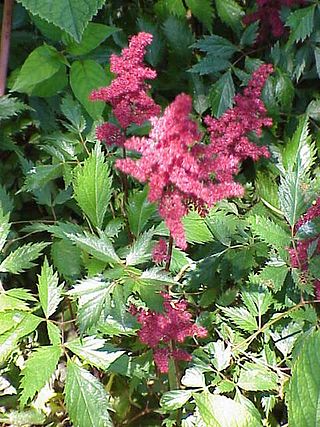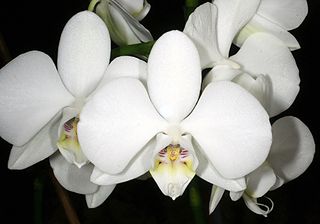
The Royal Horticultural Society (RHS), founded in 1804 as the Horticultural Society of London, is the UK's leading gardening charity.

Horticulture is the science and art of growing fruits, vegetables, flowers, or ornamental plants. Horticulture is commonly associated with the more professional and technical aspects of plant cultivation on a smaller and more controlled scale than agronomy. There are various divisions of horticulture because plants are grown for a variety of purposes. These divisions include, but are not limited to: propagation, arboriculture, landscaping, floriculture and turf maintenance. For each of these, there are various professions, aspects, tools used and associated challenges; Each requiring highly specialized skills and knowledge of the horticulturist.

John Lindley FRS was an English botanist, gardener and orchidologist.

Pseudolarix amabilis is a species of coniferous tree in the pine family Pinaceae. The species is commonly known as golden larch, but being more closely related to Keteleeria, Abies and Cedrus, is not a true larch (Larix). P. amabilis is native to eastern China, occurring in small areas in the mountains of southern Anhui, Zhejiang, Fujian, Jiangxi, Hunan, Hubei and eastern Sichuan, at altitudes of 100–1,500 m (328–4,921 ft). The earliest known occurrences are of compression fossils found in the Ypresian Allenby Formation and mummified fossils found in the Late Eocene Buchanan Lake Formation on Axel Heiberg Island.

The Award of Garden Merit (AGM) is a long-established annual award for plants by the British Royal Horticultural Society (RHS). It is based on assessment of the plants' performance under UK growing conditions.

Astilbe is a genus of 18 species of rhizomatous flowering plants within the family Saxifragaceae, native to mountain ravines and woodlands in Asia and North America. Some species are known by the common names false goat's beard and false spirea.

Deschampsia cespitosa, commonly known as tufted hairgrass or tussock grass, is a perennial tufted plant in the grass family Poaceae. The distribution of this species is widespread, with it being native to North America, Central Africa, eastern Australia and Eurasia and being introduced to South Africa, South Australia and South America.
(Ernest) Charles Nelson was a botanist who specialised in the heather family, Ericaceae, especially Erica, and whose past research interests included the Proteaceae especially Adenanthos. He was the author or editor of over 24 books and more than 150 research papers. He was honorary editor of Archives of Natural History between 1999 and 2012 and remained closely linked with the journal as one of the Associate Editors, and was honorary editor of Heathers for 23 years until 2017.
Frances Mary Perry MBE VMH was an English gardener, administrator, writer and broadcaster.

Phalaenopsis amabilis, commonly known as the moon orchid, moth orchid, or mariposa orchid, is a species of flowering plant in the orchid family Orchidaceae. It is widely cultivated as a decorative houseplant. It is an epiphytic or lithophytic herb with long, thick roots, between two and eight thick, fleshy leaves with their bases hiding the stem and nearly flat, white, long-lasting flowers on a branching flowering stem with up to ten flowers on each branch.

Kolkwitzia amabilis, commonly known as beauty bush, is a species of flowering plant in the family Caprifoliaceae. It is the sole species in genus Kolkwitzia. It is a deciduous shrub grown as an ornamental plant. In China, where it originated, the plant is called wèi shí (蝟实).

Ctenanthe is a genus of flowering plants of the family Marantaceae described as a genus in 1884. They are evergreen perennials, native to Central and South America. They are grown for their attractive, often variegated foliage. They are frost tender, requiring a minimum temperature of 13 °C (55 °F).

Ctenanthe oppenheimiana, the giant bamburanta or never-never plant, is a species of flowering plant of family Marantaceae and is a native of Brazil. It is an evergreen perennial. This plant can grow to more than 1 m (3.3 ft) tall and broad, with long narrow leaves up to 40 cm (16 in) in length. The leaves are adorned on the secondary veins with dark green bands, which meet and merge in the margins. In between are cream coloured bands. The undersides of the leaves have a red-ish colour. The cultivar 'Tricolor' is a common ornamental variety, which as a houseplant in the UK has gained the Royal Horticultural Society's Award of Garden Merit.. This cultivar is visually very similar to Stromanthe Sanguinea 'Triostar', and the two are often confused. The difference between the two lies in the lack of regular banding on the leaves of the Sromanthe, and the generally more rounded shape of the leaves in Ctenanthe.

Charles Maries was an English botanist and plant collector who was sent by James Veitch & Sons of Chelsea, London to search for new hardy plants in Japan, China and Taiwan between 1877 and 1879; there he discovered over 500 new species, which Veitch introduced to England. Amongst his finds, several bear his name, including Abies mariesii, Davallia mariesii, Hydrangea macrophylla "Mariesii", Platycodon grandiflorus "Mariesii" and Viburnum plicatum "Mariesii".

Calochortus amabilis is a species of the genus Calochortus in the family Liliaceae. It is also known by the common names Diogenes' lantern, yellow globe-tulip, golden globe-tulip, yellow globe lily, golden fairy lantern, golden lily-bell, Chinese lantern, and short lily.

Acer palmatum, commonly known as Japanese maple, palmate maple, or smooth Japanese maple (Korean: danpungnamu, 단풍나무, Japanese: irohamomiji, イロハモミジ, or momiji,, is a species of woody plant native to Korea, Japan, China, eastern Mongolia, and southeast Russia. Many different cultivars of this maple have been selected and they are grown worldwide for their large variety of attractive forms, leaf shapes, and spectacular colors.

Maranta leuconeura, widely known as the prayer plant due to its daily sunlight-dependent movements, is a species of flowering plant in the family Marantaceae native to the Brazilian tropical forests. It is a variable, rhizomatous perennial, growing to 30 cm (12 in) tall and broad, with crowded clumps of evergreen, strikingly-marked oval leaves, each up to 12 cm (5 in) long. The plant spreads itself horizontally, carpeting an entire small area of forest floor, sending roots into the substrate at each leaf node.

Roderick Leon Bieleski was a New Zealand plant physiologist. As a botanist and horticulturist, his research focussed on understanding the factors that affected the behaviour of plants, in particular horticultural crops. His work had practical relevance to farmers and orchardists in building their understanding of these factors and taking account of them while making a living from growing and harvesting plants. He received many honours and awards, culminating in being appointed Member of the New Zealand Order of Merit (MNZM) in 2010.

Hoya lanceolata is a species of flowering plant in the family Apocynaceae. It is native to the Himalayas, Nepal, Assam, Bangladesh, Myanmar, south-central China, and Vietnam. Its subspecies, Hoya lanceolata subsp. bella, the beautiful wax plant, has gained the Royal Horticultural Society's Award of Garden Merit, but some authorities recognize it as its own species, Hoya bella.

















